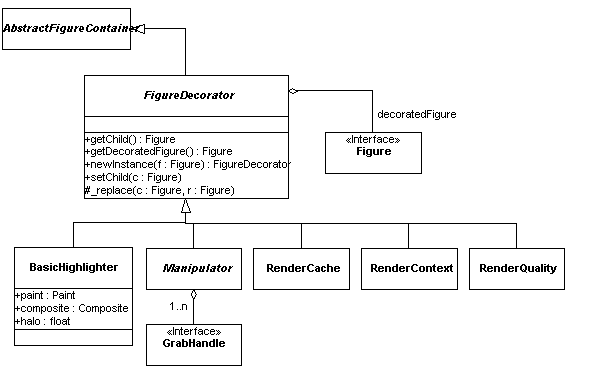|
Figure decorators
A decorator is a class that has a single child. Decorators serve a
special purpose in the Diva canvas: decorators are not proper figures,
but act as Decorators (in the sense of Gamma et al) for other figures.
Typically, decorators affect that way in which the figure it wraps is
rendered.

The diagram shows Decorator together with some of the subclasses
implemented in the Diva canvas. Any figure can be decorated by
calling the decorate() method of its parent (a FigureContainer). This
method must be implemented by containers to place the figure in the
decorator and insert the decorator in the tree in its place. Once this
has been done, the decorator will receive all paint() calls before the
decorated figure, allowing it to draw additional elements on the screen
or make other modifications that affect how the figure appears on the
screen.
In general, a decorator may also decorate another decorator. To allow
consistent access to the figures (as opposed to the decorators) that
make up the image, the decorator class has methods to access the
following related objects:
- The parent is the immediate parent;
- The container is the first ancestor that is not a decorator;
- The child is the child single child of this decorator;
- The decoratedFigure is the first descendent that is not
a decorator.
These relations are shown in this figure:

A simple example of a decorator is the BasicHighlighter class in
diva.canvas.toolbox. This class draws a translucent box around
its child, and then forwards the paint() call to the child. Another
example is the manipulator classes in diva.canvas.manipulator,
which draw a set of grab-handles over the top of various points of the
child figure.
Other classes shown in the diagram will not be implemented until a
future release of Diva. The RenderContext node contains a set of
parameters that define the current rendering context, such as the line
stroke and rendering style. The RenderQuality node attempts to provide
varying levels of rendering quality by adjusting rendering parameters.
It is intended for use in typical interactive applications, where
rendering quality can be sacrificed for performance during a user
interaction. RenderCache provides caching of a rendered figure, again
for use in interactive applications.



| 


